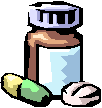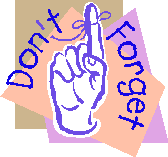DOH Medicaid Update October 2002 Vol.17, No.11 Special Edition Mandatory Generic Drug Program
Office of Medicaid Management
DOH Medicaid Update
DOH Medicaid Update October 2002 Vol. 17, No. 11
Special Edition - Mandatory Generic Drug Program
State of New York
George E. Pataki, Governor
Department of Health
Antonia C. Novello, M.D., M.P.H., Dr. P.H.
Commissioner
Medicaid Update
is a monthly publication of the
New York State Department of Health,
Office of Medicaid Management,
14th Floor, Room 1466,
Corning Tower, Albany,
New York 12237
Table of Contents
Section 1: Instructions for Prescribers
Section 2: Instructions for Pharmacists
Section 3: How to Request that a Brand-Name Drug
be Exempted from the Mandatory Generic Drug Program
Section 4: Recipient Information
Section 5: Frequently Asked Questions about the Mandatory Generic Drug Program
Special Edition - New Medicaid Law
New York State Medicaid Mandatory Generic Drug Program
Please Read and Save for Future Reference

Beginning November 17, 2002, most brand-name drugs with a generic equivalent will require a prior authorization to be covered by the Medicaid program. This new requirement is a result of legislation passed in January 2002.
If a generic drug is prescribed, no additional actions will be required. However, when writing a prescription for a brand-name drug which has a generic equivalent available, the prescriber will need to call the prior authorization line. If approval is given to dispense a brand-name drug, an authorization number will be provided. The prior authorization number must be written on the prescription or Medicaid will not reimburse the brand-name drug.
A limited number of brand-name drugs with generic equivalents are exempted from these new Medicaid requirements. There is a process to request that additional brand-name drugs be exempted from the prior authorization process for all Medicaid recipients. See Section Three for instructions on requesting an exemption.
About this Special Edition of the Medicaid Update:
This edition of the Medicaid Update provides detailed instructions, and answers to common questions for physicians, other prescribers, and pharmacists. General information on the Mandatory Generic Program and The Pharmacy and Therapeutics Committee is available on the Department of Health website.

Section One: Information for Prescribers
How to Obtain a Prior Authorization
Return to Table of Contents
Here are general guidelines for prescribers about the Mandatory Generic Drug Program. The Prior Authorization Worksheet, * with step-by-step instructions on completing the call, and the exact questions that will be asked when you make the phone call to obtain a prior authorization is available on the Department of Health website.
- Generic drugs do not require prior authorization. Only brand-name drugs with an A-rated generic require prior authorization.
- The prescriber must call the Prior Authorization Call Line to initiate the prior authorization process.
- Once approval has been given and a prior authorization number is obtained, the prior authorization number must be written on the prescription and documented on the Prior Authorization Worksheet. *
- The patient's medical record must include documentation of the patient's need for a brand, rather than a generic drug (e.g., allergic reaction to the generic product's inactive ingredients, adverse reaction to generic product's inactive ingredients, etc.). In addition, the completed prior authorization worksheet must be included in the patient's medical chart.
- Prior authorization is required for each specific prescription, not for specific patients. It is effective for up to six months. Each time a new prescription is written for the brand-name drug when a generic equivalent is available, a new prior authorization must be obtained, and the new prior authorization number written on the prescription.
- An agent of the prescriber (an employee such as a medical assistant) may complete the prior authorization call and write the prior authorization number on the prescription.
- No prior authorization is required for remaining brand name refills when the initial brand-name prescription was filled before November 17, 2002. When the current prescription expires; however, a prior authorization will be required for that patient to continue to receive the brand-name drug.
- If a prior authorization number is not on a prescription for a brand-name drug which has a generic equivalent, the pharmacy will be prohibited from filling the prescription. The pharmacy will need to contact the prescriber to ask that the prior authorization process be completed, or that the prescription be changed. If this does not occur, the patient may have to return to your office, or call your office to get the necessary prior authorization number.
- Prescriptions for brand-name drugs will continue to require "DAW" and "Brand (Medically) Necessary" on the prescription in the prescriber's own handwriting, in addition to the prior authorization number. These requirements are mandated by State and Federal law.
For billing questions, contact 1-800-343-9000.
For clinical or policy questions, contact the
Pharmacy Policy and Operations Staff at 518-486-3209

Section Two: Information for Pharmacists
Return to Table of Contents
- Generic drugs do not require prior authorization.Only brand-name drugs with an A-rated generic require prior authorization.
- Ordinarily, the prescriber initiates the prior authorization process and obtains the prior authorization number. Special rules apply for emergency supplies and when the generic drug in not available for purchase in the marketplace.
- The prescriber must write the prior authorization number on the prescription before the prescription can be billed to Medicaid. The prescription must also indicate "DAW" and "Brand (Medically) Necessary" in the prescriber's own handwriting.
- When a new prescription for a brand-name drug with an A-rated generic equivalent is presented at the pharmacy, it must include a prior authorization number. The pharmacist must contact the voice interactive Prior Authorization Call Line at 1-877-309-9493 to validate the prior authorization number prior to dispensing. Failure to validate the prior authorization number will result in the claim not being paid.
- Multiple prior authorizations for multiple patients may be validated in a single phone call.
- Initial dispensing must occur on or after the date the prior authorization number is issued and within 60 days of the date prior authorization was obtained (subject to other State laws and Medicaid restrictions).
- A prior authorization is effective for the original dispensing and up to five refills within six months (subject to other State laws and Medicaid restrictions).
- The pharmacist must include the prior authorization number on the submitted electronic or paper claim before the claim can be paid. This prior authorization number must also be included on claims for refills.
- No prior authorization is required for remaining brand name refills when the initial brand name prescription was filled before November 17, 2002. When the current prescription expires; however, a prior authorization will be required for that patient to continue to receive the brand-name drug.
- Prior authorization does not guarantee payment. Payment is subject to patient eligibility and other Medicaid guidelines.
- The Brand-Name Prior Authorization Validation Worksheet * is available on the Department of Health website.
- Phone or fax prescriptions are allowed but the original prescription, with the prior authorization number written on the prescription, must be sent to the pharmacy within five business days.
Information for Pharmacists: Prior Authorization for an
Emergency Supply or When the Generic is not Available
Return to Table of Contents
A process has been developed for Medicaid pharmacists to obtain a prior authorization in certain circumstances. It uses the same Prior Authorization Call Line 1-877-309-9493. The Pharmacy Emergency Supply/Generic Unavailable Instructions and Worksheet * is available on the Department of Health website. This process is to be initiated only by the dispensing pharmacist.
ACCEPTABLE CONDITIONS FOR THE PHARMACY GENERATED PRIOR AUTHORIZATION PROCESS:
- Emergency Supply: If a prior authorization number has not been obtained by the prescriber and the pharmacist or recipient has attempted but is unable to reach the prescriber, the pharmacist may obtain a prior authorization for up to a three (3)-day emergency supply of a brand-name drug (subject to other State laws and Medicaid restrictions). The pharmacist is expected to follow-up with the prescriber to determine future needs.
Once you obtain the prior authorization number and dispense and bill the emergency three (3)-day supply, the prescription is no longer valid for the remaining quantity and refills. - Generic Equivalent Unavailable: If the pharmacist has attempted to provide an A-rated generic for a brand-name product and the generic is unavailable for purchase in the marketplace, the pharmacist must obtain a prior authorization for the brand-name product. The prior authorization is effective for the original dispensing and up to five refills within six months (subject to other State laws and Medicaid restrictions).
GENERAL INSTRUCTIONS:
- The eight-digit prior authorization number received must be recorded on the face of the prescription and on the Emergency Prior Authorization Worksheet. Retain all completed worksheets for future reference.
- The prior authorization number must be included on the electronic or paper claim.
- For a claim to be paid, initial dispensing must occur on or after the date the prior authorization number is issued and within 60 days of the date prior authorization was issued (subject to State law and other Medicaid restrictions).
- Prior authorization does not guarantee payment. Payment is subject to patient eligibility and other Medicaid guidelines.
- The pharmacy worksheet should be reproduced for future prescriptions. The Pharmacy Emergency Supply/Generic Unavailable Instructions and Worksheet * is available on the Department of Health website.
For billing questions, contact 1-800-343-9000.
For clinical or policy questions, contact the
Pharmacy Policy and Operations Staff at 518-486-3209

The Pharmacy Generated Prior Authorization
should be used only under the following conditions:
Three-Day Emergency Supply
or
Generic Equivalent Not Available in the Marketplace
Section Three: How to Request that a Brand-Name Drug
be Exempted from the Mandatory Generic Drug Program
Return to Table of Contents
If you want to recommend that other brand-name drugs with an A-rated generic, also be exempted from the prior authorization requirements, you may submit a clinical exemption request. This process should only be used when requesting that a specific drug be exempt from the Mandatory Generic Drug requirements for all Medicaid recipients.
As other drugs are exempted, notice will be included in future issues of the Medicaid Update.
Note: It is NOT necessary to complete the Product Specific Exemption Process if requesting a patient-specific prior authorization.
- For a drug to be exempt from prior authorization, a Medicaid Mandatory Generic Clinical Exemption Request must be sent to the Department of Health, reviewed by the Department's Pharmacy and Therapeutics Committee and approved by the Commissioner of Health or her designee. Providers may not request a patient-specific exemption using this process. Product exemptions approved will exempt a particular drug for all Medicaid recipients. This is not an immediate process.
- A brand-name drug must have an "A-rated" generic equivalent to be considered for exemption. Drugs that do not have an "A-rated" generic are not subject to the Mandatory Generic law.
- Use the New York State Medicaid Mandatory Generic Clinical Exemption Request * to request an exemption. The worksheet and instructions are available on the Department of Health website.
You must print the document, complete it manually and return it by mail to the address shown on the document.
| Current Drugs Exempt from the Prior Authorization Process | |||
| The Commissioner of Health has exempted following drugs from the prior authorization process: | |||
| Clozaril® | Gengraf® | Sandimmune® | |
| Coumadin® | Lanoxin® | Tegretol® | |
| Dilantin® | Neoral® | Zarontin® | |
| These exemptions do not preclude the prescribing of their generic equivalents and should not be considered an opinion on the bioequivalency of the generic versions. NYS Medicaid encourages the use of generic equivalents when appropriate. | |||
For billing questions, contact 1-800-343-9000.
For clinical or policy questions, contact the
Pharmacy Policy and Operations Staff at 518-486-3209.
Section Four: Recipient Information
Return to Table of Contents
Materials have been developed which can be distributed to recipients to help them understand the new requirements.
Section Five: Frequently Asked Questions
Return to Table of Contents
New York State Medicaid Mandatory Generic Drug Program
Brand-Name Prior Authorization Process

Questions and Answers
General:
- How does this new law affect my practice?
- When you prescribe generic drugs, there is no additional Medicaid requirement, and no impact on your practice. This change requires additional action only when the prescriber wants the brand-name drug to be dispensed, and a generic equivalent is available.
- What products will be subject to the Medicaid mandatory generic drug law?
- Brand-name prescription drugs for which an A-rated therapeutic and generic equivalent has been approved by the federal Food and Drug Administration (FDA), and are listed in the "Approved Drug Products with Therapeutic Equivalence Evaluations" (Orange Book).
- Will this affect a lot of prescriptions?
- No, we estimate this will affect only about 5% of Medicaid claims because this new law only applies to brand-name products where the FDA has approved an A-rated generic. That means many commonly used, newer brand-name products, which do not yet have a generic equivalent, are not affected.
- Can categories of patients, rather than just individual drugs, be exempted from the mandatory generic process?
- No, we do not have the legal authority for such an approval, nor is it possible for our computerized claims processing system to undertake such a process.
- How do I know if the generic version has been "A-rated" or not?
- The very large majority of generic products approved by the FDA are A-rated. Most likely all of the brand-names with generics which you prescribe today are A-rated and will require a prior authorization. When in doubt, you may check the FDA website, at www.fda.gov, or contact a pharmacist.
- How will patients know about this program?
- Prescribers and pharmacists will be provided with educational information that can be copied for distribution and discussion with patients. In addition, we have asked for assistance from advocacy groups and associations to help distribute information.
- What recipients are affected by this new law?
- All prescriptions for recipients who are covered under the Medicaid fee-for-service program are subject to this new requirement.
- Does the Medicaid Mandatory Generic Drug program apply to prescriptions for Medicaid managed care enrollees?
- Yes, because enrollees in managed care plans use fee-for-service prescription services. Prescribers who are part of Medicaid managed care networks will need to get prior authorization when prescribing a brand-name drug with a generic equivalent.
- Does the Medicaid Mandatory Generic Drug program apply to Family Health Plus, EPIC or Child Health Plus B enrollees?
- No.
- Can medical residents or physician assistants use the institution or clinic MMIS number when requesting a prior authorization?
- No. Medical residents and physician assistants must use the supervising prescriber's MMIS number. An institution or clinic MMIS number will not be accepted.
- Does this new program apply to prescriptions written and filled in an emergency room?
- Yes, if the prescription is filled at a pharmacy which bills Medicaid.
The Prior Authorization Process for Individual Patients:
- How long will it take for a prescriber to do a prior authorization?
- About four minutes.
- Can the prescriber ask for more than one prior authorization at the same time or do they have to call back for each prescription?
- Multiple authorizations can be received with one phone call. You can get more than one prior authorization for the same patient, or authorizations for more than one patient during the same call. You will be asked at the end of each transaction if you want additional authorizations. Follow the instructions at the end of the call.
- How will you assure that prescribers can get through and not get busy signals?
- We have greatly expanded our telephone capacity to address anticipated increased volume.
- What happens to a patient who gets to the pharmacy and is told that they need a prior authorization approval to get their prescription?
- The pharmacist may contact the prescriber who may then choose to use the prior authorization system or change the prescription to a generic drug. Recipients may also contact their prescriber to discuss their prescription.
- What happens if the pharmacy cannot reach the prescriber for a prior authorization approval, and the patient needs the medication right away?
- The pharmacist may provide the patient with up to a three (3)-day emergency supply of the brand-name drug by completing the emergency prior authorization process.
- What happens if an A-rated generic is unavailable for purchase in the marketplace?
- In this case, the pharmacist must obtain a prior authorization for the brand-name drug. The prior authorization is effective for the original dispensing and up to five refills within six months subject to other State laws and Medicaid restrictions.
- Will the prescriber still need to put "DAW" and "Brand Medically Necessary" in his/her own handwriting on the prescription?
- Yes.
- What if the patient wants to get the brand-name product?
- The physician, rather than the patient, makes the decision as to the appropriate medication. The conversation with the patient may be a good opportunity for the physician to explain what generic products are, and why they might appear different (shape or color).
- Will I be able to obtain a prior authorization for a patient with temporary Medicaid authorization?
- Yes, however the pharmacist will not be able to adjudicate the claim on-line until the patient's eligibility is posted on the Medicaid eligibility file.
*These documents are available only as a portable document format (PDF) file. Click here for help using PDF files. Requests for these documents in an alternate format should be made by sending an e-mail note to: ppno@health.state.ny.us.
The Medicaid Update: Your Window Into The Medicaid Program
The State Department of Health welcomes your comments or suggestions regarding the Medicaid Update.
Please send suggestions to the editor, Timothy Perry-Coon:
NYS Department of HealthOffice of Medicaid Management
Bureau of Program Guidance
99 Washington Ave., Suite 720
Albany, NY 12210
(e-mail MedicaidUpdate@health.state.ny.us )
The Medicaid Update, along with past issues of the Medicaid Update, can be accessed online at the New York State Department of Health web site: http://www.health.state.ny.us/health_care/medicaid/program/main.htm